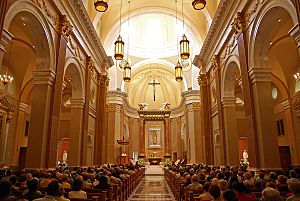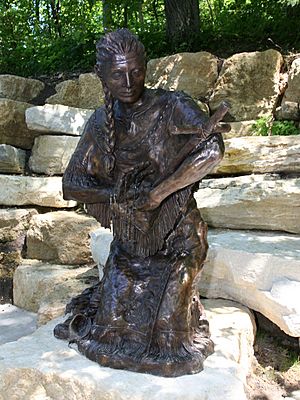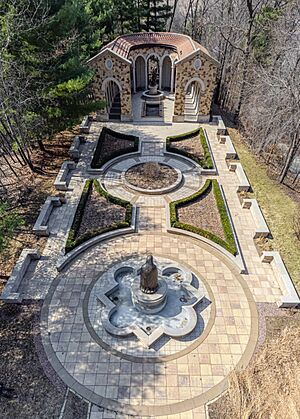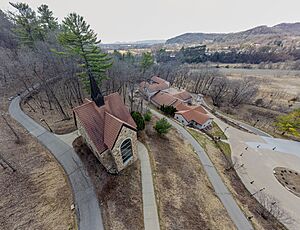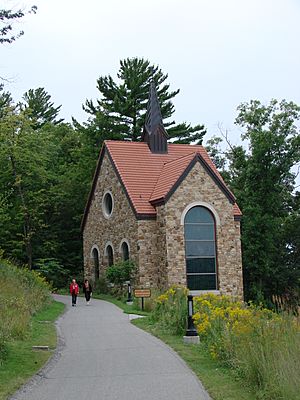Shrine of Our Lady of Guadalupe facts for kids
Quick facts for kids Shrine of Our Lady of Guadalupe |
|
|---|---|
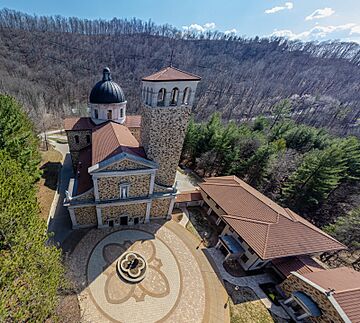 |
|
| Religion | |
| Affiliation | Roman Catholic Church |
| District | Diocese of La Crosse |
| Patron | Our Lady of Guadalupe |
| Location | |
| Location | La Crosse, Wisconsin, United States |
| Architecture | |
| Architect(s) | Duncan G. Stroik |
| Architectural style | New Classical |
| Founder | Raymond Leo Burke |
| Groundbreaking | 2004 |
| Completed | 2008 |
| Website | |
| guadalupeshrine.org | |
The Shrine of Our Lady of Guadalupe is a special place for Catholics in La Crosse, Wisconsin. It honors the Virgin Mary as she is known by the title Our Lady of Guadalupe. The shrine is set on a large piece of land, about 100 acres (0.40 km2).
Visitors can explore a visitor's center and several outdoor areas for prayer. These include a rosary walk, the Stations of the Cross, and a chapel for lighting prayer candles. Priests hold religious services like Mass every day. The shrine church was built between 2004 and 2008.
Contents
History of the Shrine
The idea for the shrine came from Cardinal Raymond Leo Burke. When he was the Bishop of La Crosse, he wanted to create a special place for Catholics to visit and pray. In 1999, he asked the Vatican for permission. The project was approved that same year.
A family donated 70 acres (280,000 m2) of wooded land for the shrine. The first part of the project was building a Pilgrim Center. This building has a gift shop and a restaurant. It also has a special chapel for lighting prayer candles. This part was finished in 2002.
Next, workers built outdoor prayer areas. They created the Stations of the Cross, a path that tells the story of Jesus's final day. They also built a garden area to honor Saint Joseph and a rosary walk. The groundbreaking for the main church building was on May 13, 2004.
The beautiful shrine church was officially opened, or dedicated, on July 31, 2008. Cardinal Burke led the special ceremony. Other important church leaders, priests, and members of Catholic groups also attended.
The Shrine Church Building
A Classic Style of Architecture
The shrine church was designed by architect Duncan G. Stroik. He used a style called New Classical, which is based on old Italian Renaissance designs. This was one of the first Catholic churches built in this style in 50 years. The outside of the church is made of stone from Minnesota and Wisconsin. It was designed to look like buildings in Tuscany, a region in Italy.
Inside the Church
The inside of the church was inspired by a famous church in Rome called the Basilica of St. Mary Major. The floor plan is shaped like a cross. The floors are made of marble, and the pews and doors are made of dark mahogany wood.
The ceiling of the church's dome is painted to look like the night sky. It shows the stars as they would have appeared over Mexico City on the winter solstice in 1531. This is the year that Our Lady of Guadalupe is said to have appeared. The church also has 31 beautiful stained-glass windows.
A large painting, called a fresco, is near the main entrance. It tells the story of Mary's appearances to Juan Diego. There are also paintings of six different saints along the side aisles of the church.
Sculptures and Mosaics
There are many statues made of white Carrara marble from Italy. Outside, a statue of Jesus as the Good Shepherd stands over the entrance. Statues of Saint Peter and Saint Paul are on either side. In the plaza, a sculpture shows Juan Diego showing his special cloak, or tilma, to the bishop.
Inside the church, there are statues of the Sacred Heart of Jesus, the Immaculate Heart of Mary, Saint Joseph, and Juan Diego.
The main focus of the church is a large mosaic of Our Lady of Guadalupe. It was made by artists at the Vatican. The mosaic is very tall, measuring 9 feet (2.7 m), and is 6 feet (1.8 m) wide.
Holy Relics at the Shrine
The shrine holds several holy items called relics. These are small objects connected to a saint, often a piece of bone or clothing. Catholics believe these items are special. The shrine has first-class relics of several saints, including:
- Miguel Pro
- Kateri Tekakwitha
- Thérèse of Lisieux
- Peregrine Laziosi
- Maria Goretti
- Faustina Kowalska
- Gianna Beretta Molla
Exploring the Shrine Grounds
The shrine grounds are large and have many peaceful places to visit. The paths are easy to walk, and there is help for people who have trouble moving around.
Outdoor Prayer Areas
The Stations of the Cross path has bronze sculptures that show scenes from Jesus's final hours. The Rosary Walk has four small shelters, each with five blue tiles that show the mysteries of the rosary prayer.
A special area is dedicated to Saint Joseph the Workman. It has a fountain and a bronze sculpture of Saint Joseph teaching a young Jesus. Another quiet spot has a large bronze statue of Saint Kateri Tekakwitha, a Native American saint.
Memorial to the Unborn
The Memorial to the Unborn is a peaceful, covered walkway. It offers a quiet place for families to remember and honor children who passed away before they were born. It is designed to be a place of spiritual healing and comfort.
Votive Candle Chapel
The Mother of Good Counsel Votive Candle Chapel is a round room filled with 576 prayer candles. Visitors can light a candle as a special prayer. The chapel is surrounded by seven stained-glass windows showing Mary with different titles.
Visitor Information
The Culina Mariana Café is a restaurant in the Pilgrim Center that serves food in a European style.
The Flores Mariae Gift Shop is also in the Pilgrim Center. It sells books about the Catholic faith, religious items, and souvenirs.
See also
- Peter Fehlner, a former leader of the shrine
- Holy Hill National Shrine of Mary, Help of Christians, Erin, Wisconsin
- National Shrine of Our Lady of Champion, Green Bay, Wisconsin


